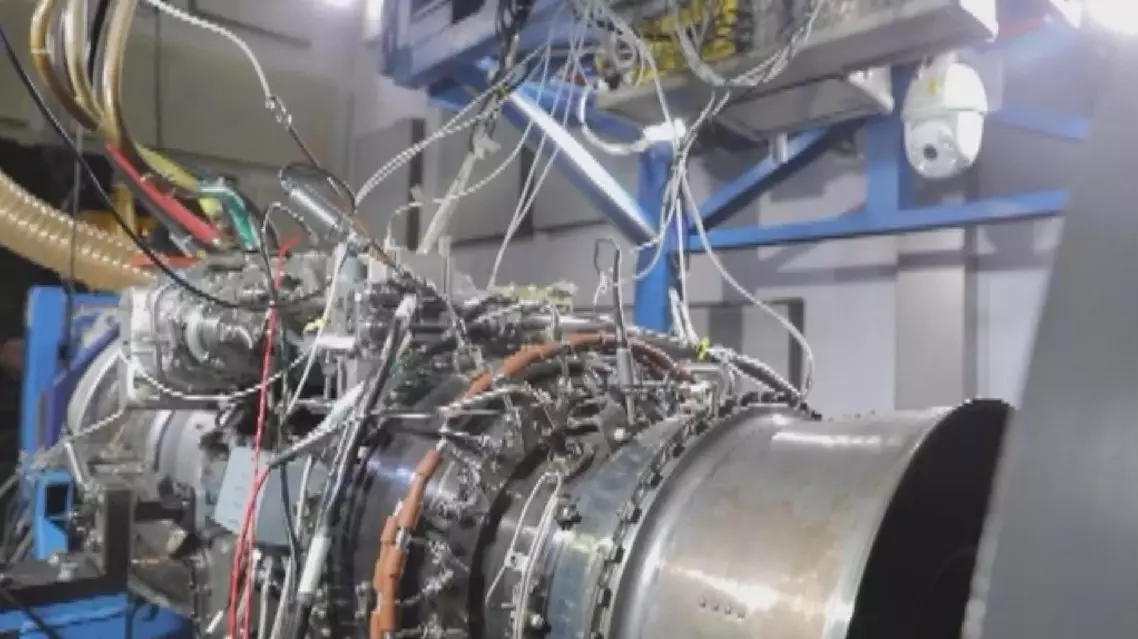The AES100, China's first independently developed civil aviation engine series which caught much limelight at the just-concluded 15th Airshow China, demonstrates high performance capabilities featuring serial development of both turboprop and turbofan for a wide range of civil aircraft and drones for the burgeoning low-altitude economy, which will significantly fill gaps in the development of civil aviation engines.
The AES100, China's first domestically developed civil aviation engine series, demonstrates significant progress in serialization, as its base turboshaft version evolves into a comprehensive series designed for diverse applications, facilitating ongoing development that addresses gaps across various fields.
The AES100 is a 1,000 kilowatt-class, civilian-grade advanced turboshaft engine characterized by its high efficiency, long lifespan, high reliability, high power reserve and good extendability, which makes it China's first such engine with full intellectual property that is competitive on the global market.
A single AES100 engine can provide sufficient lift for a helicopter with three to four tons of takeoff weight, and two AES100s would be enough to power a helicopter with five to six tons of takeoff weight.
The AES100 engine obtained the type certificate from the Civil Aviation Administration of China (CAAC) just three months ago, a milestone in the country's independent development of advanced civil aero engines.
According to the civil aviation engine development experience of other countries, it typically takes more than a decade for an aero-engine to obtain a type certificate. However, the AES100 was developed in less than ten years, setting a new record for domestic civil aviation engine development.
"The AES100 engine was developed in a relatively short period, thanks to over 50 years of research and development experience of our institute. With a complete team of specialized human resources, and with the various established test conditions that meet airworthiness requirements, we were able to achieve success in the development process on the first attempt," said Li Xin, deputy director of China Aviation Power Machinery Research Institute.
Designed to support general aviation and the burgeoning low-altitude economy, the AES100 targets the vast market opportunities arising from China's focus on this sector.
The AECC announced in mid-November that it has signed purchase orders and cooperation contracts for the supply of over 1,500 engines of the AES100 series, with a total order value exceeding 10 billion yuan (about 1.39 billion U.S. dollars).
This is the largest number of orders it has ever received in history, according to the Chinese aero engine maker at the week-long 15th Airshow China, officially known as the 15th China International Aviation and Aerospace Exhibition, which ended in the port city of Zhuhai in south China's Guangdong Province on November 17.
"The driving effect of the low-altitude economy's development to our field is quite remarkable, as many drone platforms have emerged in the market, creating numerous new application scenarios. This drives us to continually develop new products and enhance new technologies in line with market demands," Li said.
Another feature of the AES100 is its rapid development in serialization under a same brand family. In serial development of the AES100, the manufacturer says it will, focusing on a single platform, strives to develop a series of engine products with differences. In particular, it will, targeting the various application scenarios, manage to enable the AES100 engines to keep filling gaps in the various fields.
So far, researchers, on the basis of the AES100, have not only succeeded in developing turboprop and turbofan engines suitable for small and medium-sized turboprop aircraft and business jets, but have also rolled off hybrid power variants that offer diverse power solutions for vertical takeoff and landing as well as fixed-wing flight. These innovations can be widely utilized in general aviation, medical rescue, tourism, sightseeing, and more.
"We now have a relatively complete aviation engine industry chain and supply chain, with multiple civil aviation engine products going on the market in recent years. We have developed various products including hybrid and hydrogen-powered engines to meet future green and low-carbon requirements. These products are highly technologically advanced, safe and reliable. The results of our communication with the users following the supply of AES100 engines to the market also indicate that our products are capable of meeting the standards of similar products on the international market," he said.
The company has also released a report on the civil aero engine market, forecasting that the Chinese market is expected to receive 19,000 aero engines, over one-fifth of the global market share, in the next two decades, with a total value exceeding 300 billion U.S. dollars.
In the next 20 years, the global commercial turbofan engine deliveries will exceed 87,000, valued at approximately 1.5 trillion U.S. dollars. Additionally, by 2043, China's commercial turbofan fleet will expand to over 21,000 engines, according to the report.

China's groundbreaking AES100 aviation engine demonstrates high performance capabilities









